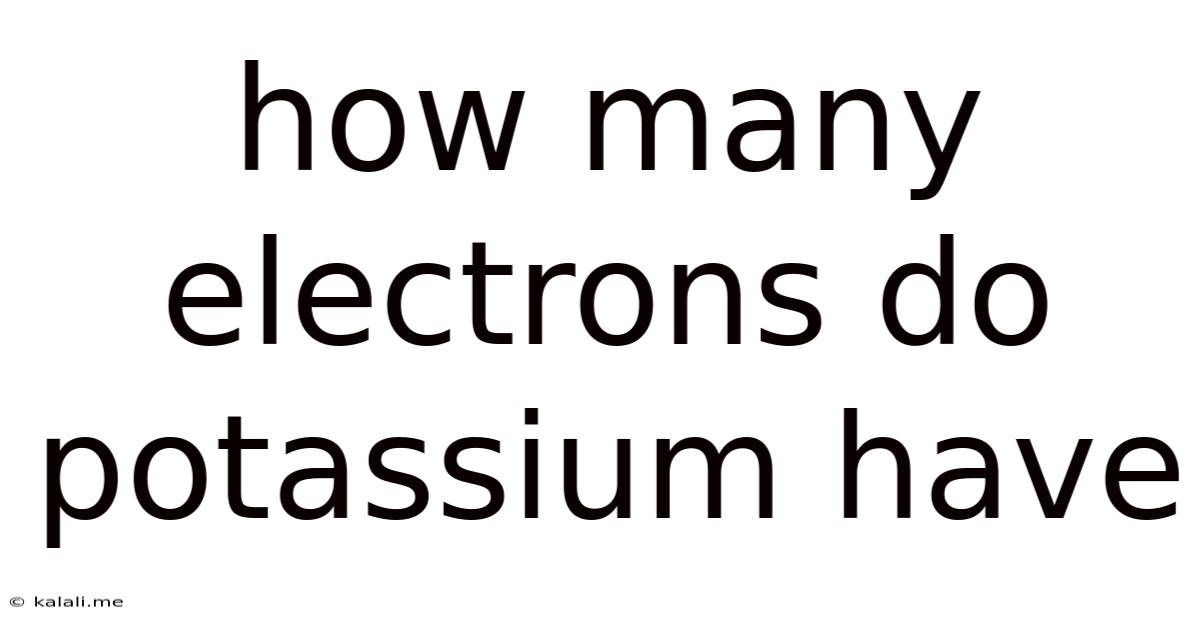How Many Electrons Do Potassium Have
Kalali
Jun 11, 2025 · 2 min read

Table of Contents
How Many Electrons Does Potassium Have? A Deep Dive into Atomic Structure
Potassium, a crucial element for human health and a common component in fertilizers, plays a significant role in various fields. Understanding its atomic structure, specifically the number of electrons it possesses, is fundamental to comprehending its chemical behavior and properties. This article will delve into the answer to the question: how many electrons does potassium have? and explore related concepts.
Understanding Atomic Structure: Protons, Neutrons, and Electrons
Before we answer the central question, let's briefly review the fundamental components of an atom. Every atom consists of a nucleus containing positively charged protons and electrically neutral neutrons, surrounded by a cloud of negatively charged electrons. The number of protons defines the element's atomic number, and in a neutral atom, the number of protons equals the number of electrons.
Potassium's Atomic Number and Electron Configuration
Potassium, represented by the symbol K, has an atomic number of 19. This means a neutral potassium atom contains 19 protons. Consequently, a neutral potassium atom also possesses 19 electrons.
Understanding the electron configuration helps visualize how these electrons are arranged. Electrons occupy specific energy levels or shells around the nucleus. Potassium's electron configuration is 2, 8, 8, 1. This means:
- Shell 1: 2 electrons
- Shell 2: 8 electrons
- Shell 3: 8 electrons
- Shell 4: 1 electron
This outermost electron in the fourth shell is a valence electron, playing a crucial role in potassium's chemical reactivity. It readily participates in chemical bonding, explaining potassium's tendency to lose this electron and form a +1 ion (K⁺). This single valence electron is responsible for many of potassium's characteristic properties.
Potassium Ions and Electron Count
It's important to note that the number of electrons can change when potassium participates in chemical reactions. When potassium loses its valence electron, it becomes a positively charged ion (K⁺), possessing only 18 electrons. This ion is more stable due to having a full outer electron shell. This ionic form is prevalent in many potassium compounds.
The Significance of Electron Count in Chemistry
The number of electrons an atom possesses directly impacts its chemical properties, influencing its reactivity, bonding behavior, and the formation of various compounds. Potassium's single valence electron makes it highly reactive, readily forming ionic bonds with elements like chlorine (forming potassium chloride, KCl), a crucial compound for various applications.
In summary, a neutral potassium atom contains 19 electrons. However, understanding its electron configuration and its tendency to lose one electron to form a stable ion is essential to fully grasp its chemical behavior and importance in different fields. The easily lost valence electron contributes to its reactivity and its role as an essential element in biology and chemistry.
Latest Posts
Latest Posts
-
How Many Hours Is 9am To 1pm
Jul 01, 2025
-
How Fast Is 200 Km Per Hour
Jul 01, 2025
-
How Many Babies Were Conceived At Woodstock 1969
Jul 01, 2025
-
How Many Feet Is In 40 Yards
Jul 01, 2025
-
Least Common Denominator Of 9 And 7
Jul 01, 2025
Related Post
Thank you for visiting our website which covers about How Many Electrons Do Potassium Have . We hope the information provided has been useful to you. Feel free to contact us if you have any questions or need further assistance. See you next time and don't miss to bookmark.